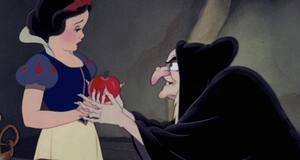A Generation of Men Raised by Women: Gender Constructs in 'Fight Club'
By
2010, Vol. 2 No. 04 | pg. 2/2 | « Enter Marla Singer, sporting wild, Medusa-like hair, bug-eye sunglasses, and loudly clacking high-heels. She walks boldly into the room, smoking a cigarette, and asks in a deep, raspy voice, “This is cancer, right?” without so much as a smile or greeting. Jack is immediately unnerved by her, as she obviously does not have testicular cancer. He sees her in his other support groups, and knows that she is, like himself, a tourist. This knowledge throws Jack off kilter: “Her lie reflected my lie. And suddenly, I felt nothing. I couldn’t cry. So once again, I couldn’t sleep” (Fight Club). Jack confronts Marla and tells her he wants her to leave; Marla is completely unfazed and walks away. Jack runs after her and follows her out the door and down the street to a Laundromat, attempting to negotiate some kind of compromise. Marla still appears unaffected, but agrees to split up the support groups. She leaves the Laundromat and walks across the street without looking either way, bringing traffic to a halt; Jack, after stopping to make sure he won’t be hit, follows her. The come to a final agreement on who will attend which support groups; Marla calls it a deal and sticks out her hand to be shaken, and walks out the door without a goodbye. Throughout this entire scene, Marla is the one who exhibits recklessness and confidence—traditionally male qualities—leaving Jack trailing fretfully in her wake. Soon after this, Jack encounters Tyler Durden (Jack’s alter-ego), who he moves in with after coming home to find his apartment complex on fire. Tyler’s attitude towards life is the epitome of stereotypical masculinity—he is careless, destructive, violent, cocky, and slightly grimy-looking. He rubs off very noticeably on Jack, who begins to exhibit similar traits. By the time we see Marla again eight weeks have passed, during which time Jack morphs into somewhat of a replica of Tyler.She calls to ask why Jack hasn’t been attending his support groups and to calmly inform him that she has probably overdosed on Xanex. The camera shows her with her head resting on a dirty, case-less pillow: not a very “feminine” thing to do, and in direct contrast with Jack’s spotless apartment in the beginning of the film. However, whereas throughout their first conversation when Jack was chasing after her trying to get her to listen, in this scene, Marla continues talking to Jack after he simply leaves the phone off the hook and walks away. This shows markedly how much Jack has changed since meeting Tyler. The next morning, Jack find Marla in his kitchen and asks what she’s doing there. She cusses at him and leaves (because Jack is Tyler), after which Tyler walks into the kitchen and tells Jack that he slept with her the night before, and Jack is immediately upset by her again. The screen flashes back to Tyler picking up the phone Jack left, going to get Marla from her apartment, and bringing her home. Throughout this scene, Marla is her standard obscene self—cussing, generally being a mess, and lacking completely anything that might be described as lady-like. Tyler and Marla continue sleeping together, which bothers Jack. A few scenes later, Marla calls Jack because she thinks she’s found a lump in her breast. Jack is not sure how to deal with this, but he goes to her apartment anyway. When he shows up, she offers him a stolen boxed lunch, saying she got it for him, and she asks concernedly about a burn on his hand—both motherly, feminine actions. This marks Marla’s shift away from the more masculine traits in her character, which occurs only after she is forced to face the distinctly feminine threat of a lump in her breast. She continues on this very feminine cant by kissing Jack a thank-you after he examines her breast and fails to find a lump, and then by appearing frustrated and disappointed when Jack asks if they are done (because she and Jack have been sleeping together for some time, even though Jack is unaware of it). By the time Jack realizes that he and Tyler are actually the same person, Marla has grown visibly fond of him, as well as visibly frustrated with the huge inconsistencies of his character. As Project Mayhem is about to set off a major act of terrorism, Jack is attempting to undo what he has done while being Tyler. He apologizes to a furious Marla, and jumps in front of a bus to stop it and try and make Marla board and get to safety. This particular act marks another huge change in Jack—who at the beginning of the film, looked both ways before crossing the street after Marla. Additionally, Jack, previously a non-violent person, resorts to violence in order to try and prevent Project Mayhem’s plan from succeeding, eventually shooting himself in the mouth in order to rid himself of Tyler. He takes responsibility for what he has done as Tyler, and takes charge of the situation, ordering the members of Project Mayhem to leave. In the final scene, Marla starts to berate Jack for everything he’s cause her to go through, but she stops when she sees that he’s been shot. She is genuinely upset by this and immediately starts “playing nurse” and trying to help him. When the buildings around them start exploding, Jack tells Marla that he is fine and that everything is going to be all right. Both Marla and Jack go through tremendous changes in character throughout the movie. The violence they both experience transforms Jack into a stronger person—making him more self-aware and assertive—and Marla into a more sensitive person—making her softer and less callous. Whereas Jack displays the more feminine traits in the beginning of the film, and Marla the more masculine, now each has given up some of those opposing gender qualities and absorbed more of that of their own gender. The impression we are left with at the end of Fight Club is that the rearrangement of Marla and Jack’s masculine and feminine traits leads them to become better people. Marla, as a more feminine woman, is more tender towards Jack, and thus more appealing to him. Jack, as a more masculine man, is more confident towards Marla, and thus more appealing to her. This suggests that only through the proper alignment of masculine and feminine traits can one truly achieve good character and proper ethos. While feminists and supporters have worked vigorously in an attempt to blur the lines of gender constructs, this shows that despite the progress made, they are still very apparent in modern culture, and modern society. ReferencesCovino, William A., and David A. Joliffe. Rhetoric: Concepts, Definitions, Boundaries. Boston, MA: Allyn and Bacon, 1995. Fight Club. Dir. David Fincher. By Chuck Palahniuk. Perf. Edward Norton, Brad Pitt, and Helena Bonham Carter. 20th Century Fox, 1999. DVD. Hart, Robert P., and Suzanne Daughton. Modern Rhetorical Criticism. Boston, MA: Allyn and Bacon, 2004. Print. "Timeline of Love - Famous Couples -." Biography.com. Web. 21 Oct. 2009. Suggested Reading from Inquiries Journal
Inquiries Journal provides undergraduate and graduate students around the world a platform for the wide dissemination of academic work over a range of core disciplines. Representing the work of students from hundreds of institutions around the globe, Inquiries Journal's large database of academic articles is completely free. Learn more | Blog | Submit Latest in Film & Media |


















